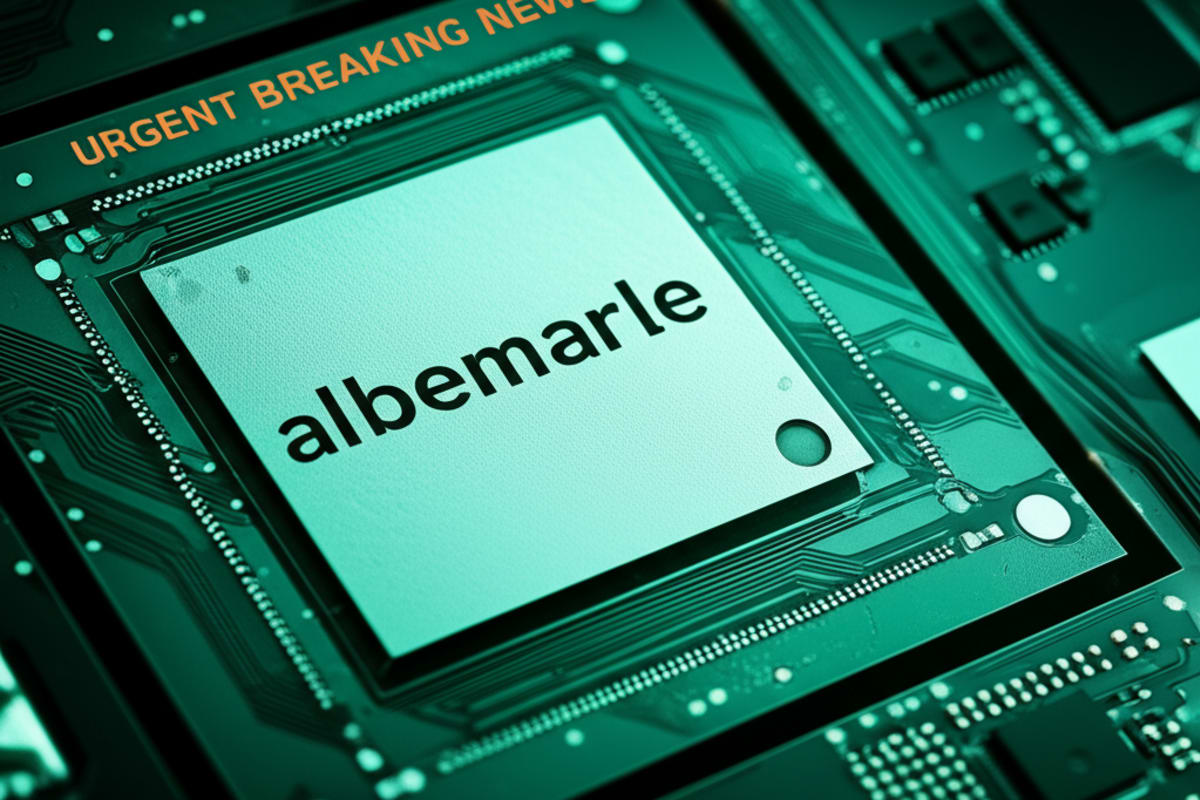Lithium King Albemarle Sheds Catalyst Arm to Battle Debt

The global energy transition is a rollercoaster, isn't it. One minute, a commodity is hotter than a summer afternoon in Jakarta, and the next, its value dips faster than a market correction.
Background
That's precisely the bumpy ride Albemarle Corp. , the undisputed titan of the lithium world, has been on.
And now, the company's making a big move, a strategic pivot that speaks volumes about the current state of the battery metal market. Today, October 27, 2025, Albemarle announced it’s offloading its refining catalyst business, a significant divestiture aimed at raising a cool $660 million.
Simple: to cut down on debt and inject some much-needed cash into its coffers.
It’s a bold step, driven by what the company terms “persistently low prices” for lithium, the very metal fueling our electric dreams and, increasingly, our mobile lives
For years, Albemarle has been synonymous with lithium.
They're not just a player; they're the player, supplying a huge chunk of the world’s demand for the silvery-white metal crucial for electric vehicle (EV) batteries, consumer electronics, and grid-scale energy storage
Their fortunes have often mirrored the soaring ambitions of the EV industry. Remember when lithium was dubbed ‘white gold’ and prices seemed to know no ceiling.
Those days feel like a distant memory now. The past year or so has seen a significant shift.
What was once a supply-constrained market grappling to keep up with insatiable demand for EVs and battery production, has recently swung towards oversupply
New mines came online, existing operations ramped up, and a slight cooling in global EV sales growth in some segments led to an imbalance
This isn't to say the EV revolution is stalling – far from it – but the rapid expansion caught up, creating a glut that's pushed prices down from their stratospheric highs
A Strategic Retreat from CatalystsAlbemarle isn't a one-trick pony, though lithium is undoubtedly its crown jewel
The company has historically operated other segments, including bromine specialties and, of course, the refining catalysts business it’s now shedding.
This catalyst arm produces materials vital for processing crude oil and other petroleum products
It’s a stable, mature business, but it's not lithium.
And in a world rapidly transitioning away from fossil fuels, its long-term growth prospects might not align with Albemarle's core strategic vision
So, why sell it now. Think of it like a captain jettisoning non-essential cargo during a storm.
The storm here isn't a full-blown crisis, but rather the turbulent waters of the lithium market.
By selling the catalyst business, Albemarle isn't just raising $660 million; it's streamlining its operations, focusing its energy, and crucially, shoring up its balance sheet
This isn't just about paying down debt; it's about freeing up capital to continue investing in its core lithium operations – to innovate, expand, and remain competitive when the market eventually rebalances
“It’s a pragmatic move,” noted one market analyst we spoke with, requesting anonymity
“When your main commodity is under pressure, you look for ways to strengthen your core. Divesting a non-core asset, especially one from a legacy business, makes perfect sense.
It’s about ensuring long-term resilience in the face of market volatility.
”What This Means for Albemarle and the MarketThe $660 million injection won't magically solve all the challenges stemming from low lithium prices, but it's a significant step
Debt reduction improves a company's financial health, making it more resilient to market downturns and potentially more attractive to investors.
It also gives Albemarle more flexibility to manage its capital expenditures in its lithium projects, whether it's developing new brine operations in the Atacama Desert or expanding hard-rock mines in Australia
For the broader lithium market, this move by Albemarle could be a signal. When the biggest player makes such a definitive strategic shift, it underscores the current pressures facing the industry.
It might also suggest that the path to profitability for lithium miners will increasingly depend on efficiency, cost control, and a sharp focus on core assets rather than diversified portfolios
The Southeast Asian Connection: Beyond the MinesNow, let’s bring this closer to home, especially for our readers in Southeast Asia
You might think, “Albemarle’s operating in South America or Australia, how does this affect me. ” Well, it matters a great deal.
The region is quickly positioning itself as a vital hub in the global EV supply chain, moving beyond just assembly to battery manufacturing and, eventually, perhaps even upstream processing
Countries like Indonesia, with its vast nickel reserves, are pouring billions into developing integrated EV ecosystems
Thailand is actively wooing EV manufacturers with incentives, while Vietnam's VinFast is making waves internationally. What do all these ambitions rely on.
A stable, affordable, and secure supply of key battery minerals, including lithium.
When a major producer like Albemarle, which holds significant sway over global lithium supply, adjusts its strategy due to price volatility, it sends ripples
Lower lithium prices might temporarily reduce input costs for battery manufacturers setting up shop in, say, Malaysia or the Philippines.
This could make regional EV production more competitive globally
However, persistently low prices also mean less investment in new lithium supply, potentially leading to future supply crunch when demand inevitably surges again
This creates a challenging environment for regional players hoping for long-term price stability to plan their own multi-billion dollar battery gigafactories
It's a delicate balance, and Albemarle's actions reflect the industry's navigation of this tightrope.
Furthermore, if Albemarle focuses even more intensely on lithium, it means a more disciplined and potentially more efficient supply partner for the burgeoning battery and EV industries in places like Singapore, Thailand, and Indonesia
Their stability is our stability, in a way. Looking Ahead: A Future in FluxSo, what’s next.
The $660 million deal is expected to close in due course, allowing Albemarle to reallocate resources. This isn’t just a financial transaction; it’s a reassertion of identity.
Albemarle is doubling down on its commitment to lithium, betting big on the long-term trajectory of electrification, even as it navigates short-term market headwinds
It's a clear signal that they believe the future is electric, and they intend to be at its very core, even if the journey there comes with a few strategic detours and divestitures
The market will be watching closely to see if this calculated move pays off, cementing Albemarle's leadership through the inevitable ebb and flow of the energy transition
For those of us tracking the pulse of the global economy and the clean energy revolution, Albemarle's decision isn't just about a company selling off an asset
It’s a microcosm of the larger, dynamic forces at play, reminding us that even the most promising industries aren’t immune to market cycles and the constant need for strategic adaptation
It’s a story of resilience, focus, and the relentless pursuit of efficiency in a world that never stops changing
